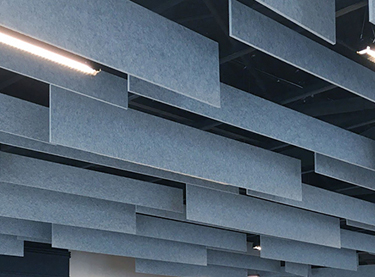What is the working principle of PET acoustic panels
2023-08-10
What is the working principle of PET acoustic panels
PET (Polyethylene Terephthalate) acoustic panels are designed to absorb sound and reduce noise in various environments. These panels are often used for acoustic treatment in spaces such as offices, conference rooms, auditoriums, studios, and homes. The working principle of PET acoustic panels involves sound absorption and diffusion through their construction and material properties.
Here's how PET acoustic panels work:
Material Composition: PET acoustic panels are made from PET fibers, which are derived from recycled plastic bottles. These fibers are processed and compressed to form the panel's structure. The fibers are then arranged in a specific pattern to enhance their acoustic properties.
Sound Absorption: PET acoustic panels are designed to absorb sound waves that strike their surface. When sound waves reach the panel, they enter the fibers and interact with the material. The fibrous structure of the PET panels helps to dissipate and transform sound energy into tiny vibrations within the fibers. This process converts sound energy into heat energy, effectively reducing the intensity of the sound wave.
Internal Cavities: Many PET acoustic panels have internal cavities or air gaps between the fibers. These cavities help to trap and absorb sound waves more effectively. The sound waves that enter the cavities bounce around and lose their energy as they encounter the multiple surfaces within the cavities.
Diffusion and Scattering: PET acoustic panels also contribute to sound diffusion and scattering. The irregular surfaces and textures of the panel's fibers cause sound waves to bounce off in various directions rather than reflecting directly back. This scattering effect helps to break up the direct path of sound waves, reducing the potential for sound waves to create strong echoes or reverberations.
Frequency Range: PET acoustic panels are engineered to absorb sound across a range of frequencies, including mid to high frequencies. They are particularly effective at addressing issues related to speech intelligibility, reducing echoes, and improving overall sound quality within a space.
Installation: PET acoustic panels are typically mounted on walls or ceilings using various methods such as adhesive, clips, or frames. Their installation placement is strategic, considering the room's acoustics and the location of sound sources and listeners.
In summary, PET acoustic panels work by absorbing sound energy through the interaction of sound waves with the PET fibers. The panels convert sound energy into heat and also contribute to sound diffusion, scattering, and frequency absorption. This combination of features helps to improve the acoustics of a space by reducing noise, echoes, and reverberation, leading to a more comfortable and effective environment for communication and other activities.

























































